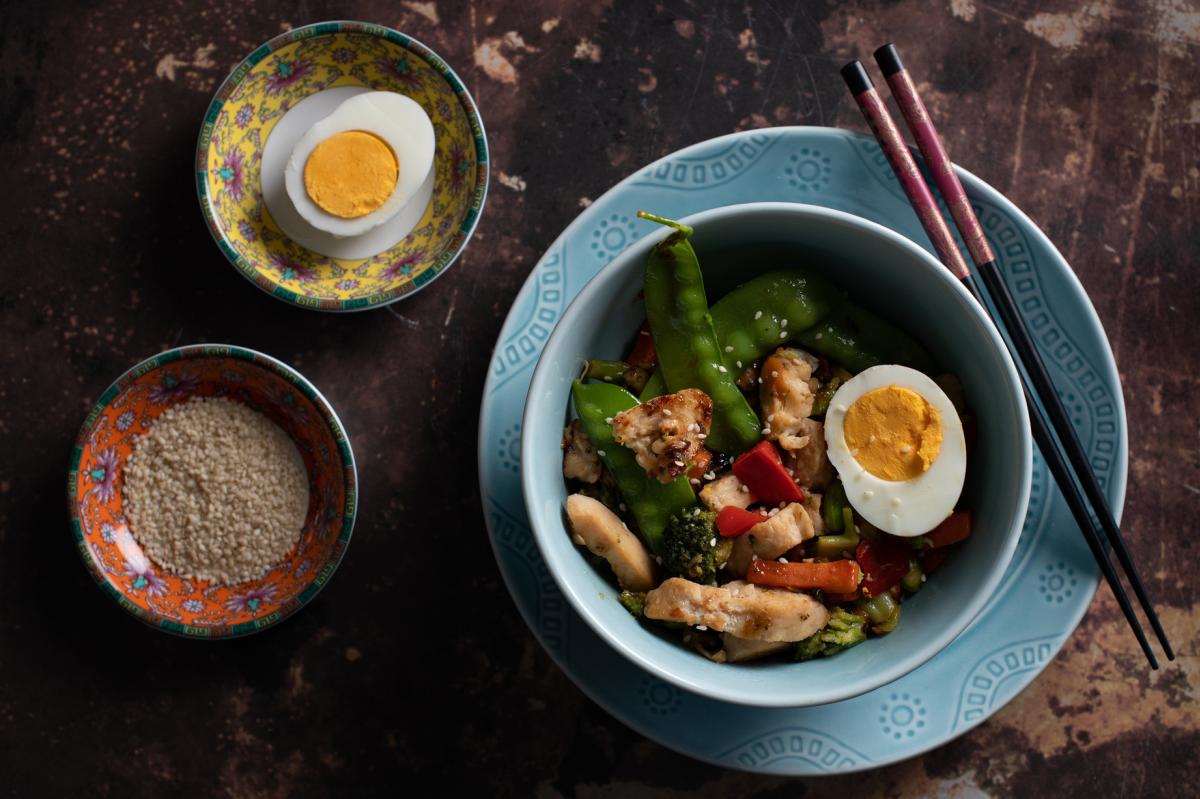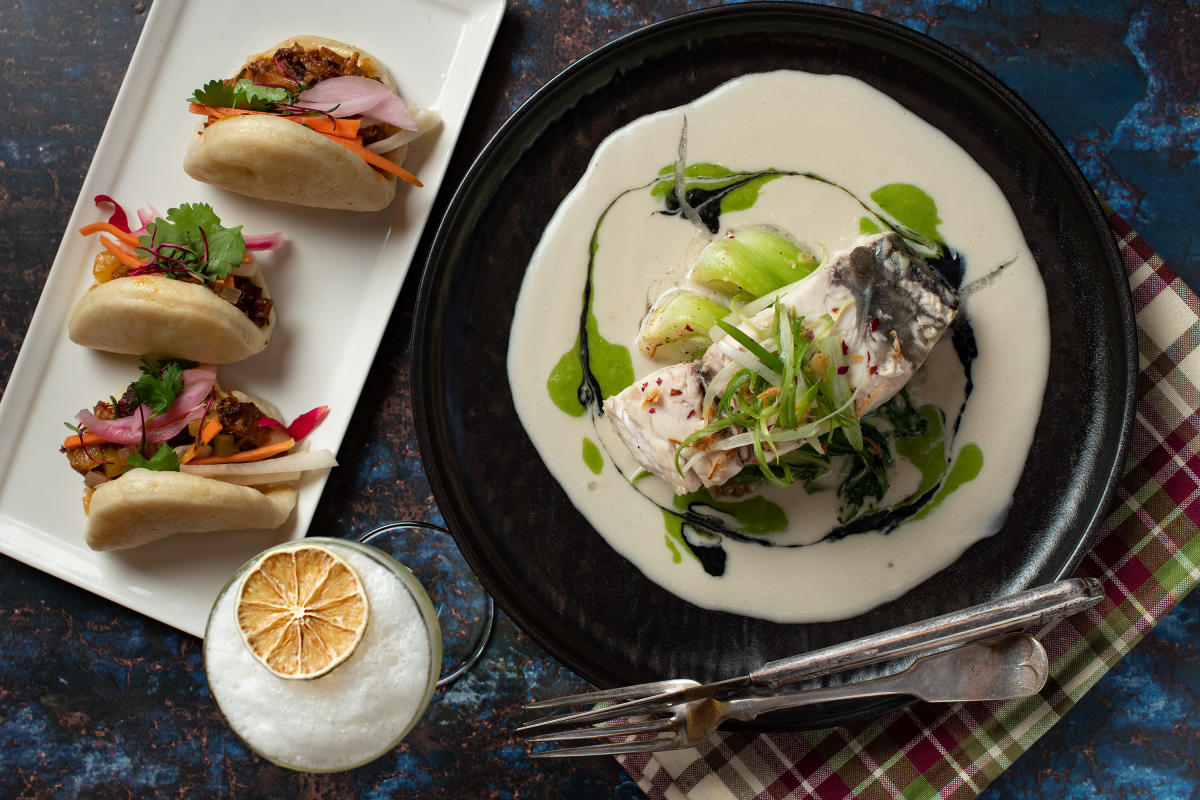IN THE 1920S AND ’30S, ONE OF THE HOTTEST spots in Santa Fe was a Chinese-American restaurant. Members of Santa Fe’s artists-and-writers colony shared tables, stories, and chop suey at Henry Gee Gay and George Gee Park’s New Canton Café on East San Francisco Street. Businessmen, journalists, and politicians were also regulars. Radio personality Larry Bynon reportedly longed for the café’s T-bone steaks while he was stationed in the Pacific during World War II, and U.S. Senator Bronson Cutting praised the turtle soup.
The New Canton Café closed in 1975, after more than 50 years in business, but its success story still resonates. When Chinese immigrants—most from Canton province in southern China—streamed into the country in the 1800s to work on farms and factories, in the gold fields, and on the transcontinental railway, they were first welcomed and then reviled. The xenophobic backlash was institutionalized in the Chinese Exclusion Act of 1882, which restricted travel, employment, and additional immigration. But a loophole in that law granted special merchant visas for “high grade” restaurants. Thanks to the “Lo Mein Loophole,” the number of Chinese restaurants in the U.S. doubled between 1910 and 1920, then doubled again between 1920 and 1930. By the time the Exclusion Act was repealed in 1943, Chinese (or Americanized Chinese) cuisine had moved into the mainstream.
The Chinese who came to New Mexico in the early years worked in mines and on the railroad. Many stayed when the work dried up, opening restaurants specializing in an American-born concoction called chop suey—usually diced chicken or pork, stir-fried with an assortment of chopped veggies and drenched in a thick brown sauce. These sorts of specialties gradually won over Americans accustomed to a much blander diet. And although Chinese cuisine and its Americanized dishes are not what anyone thinks of first when it comes to the Land of Enchantment, more than a century later, the influence of Chinese restaurants on New Mexico’s increasingly diverse dining scene has endured.
For example, Chen’s Chinese Restaurant has been dishing up chop suey in Albuquerque for more than 40 years. The Chinese Restaurant Foundation Legacy Awards have recognized several other New Mexico longtimers: the Gold Dragon Chinese Restaurant, in Tucumcari, in business for more than three decades; Chow’s Asian Bistro, in Santa Fe (30 years); and the Super Buffet, in Gallup (27 years). Mikasa 2 Chinese Restaurant, in Window Rock, and California Chinese Fast Food, in Gallup, have also been recognized.
JENNIFER 8. LEE, AUTHOR OF THE FORTUNE Cookie Chronicles, has a set of criteria to judge whether a restaurant is cooking Chinese food for Chinese people, Chinese food for other people—or both—even before she picks up a set of chopsticks. Tucked beside an Indian grocer in Albuquerque’s Louisiana Plaza, Neo Szechuan Asian Kitchen meets most of Lee’s benchmarks.
The waitstaff speaks more Mandarin than English, and the bilingual menu lists no chop suey among its nearly 100 offerings and specials. The daily chef’s specials are written in characters on a whiteboard.
Both fish and Peking duck are on the menu. A fish hot pot special contains silky white fillets floating in a light but intense red broth, glistening with Szechuan chili oil, peppercorns, and whole peppers. Topped with a sprinkle of green onions, sprouts, and cilantro, it’s lip-tingling but not pain-inducing.
General Tso’s chicken, which did not originate in China, is battered and deeply fried, the way many Americans like it. The juicy, crispy, sweet, and salty cubes of dark chicken are complemented by uniformly cut and perfectly cooked broccoli florets. Kung Pao chicken, a similar but more traditional stir-fried Szechuan dish incorporating peanuts, is spicier and less sweet. In both cases, the meats were tender and juicy, a sign of the Chinese marinating technique called velveting.
Open for a little more than a year, Neo has caught the attention of critics and Burqueños, especially the Chinese community in Albuquerque—almost all overheard phone orders are conducted in Mandarin.
SOMETIMES YOU CAN FIND CREDIBLE CHINESE dishes tucked into the most unexpected places—like The Wrap, a small sandwich, soup, and salad shop on Santa Fe’s bustling East Water Street, a stone’s throw from the Plaza.
Jieyi He, who owns the café with her soon-to-be husband, Sean Thomas, came to the U.S. at age 12 from the southern Chinese city of Nanning. Thomas and He repurposed a former sushi café to offer a range of grab-and-go choices for locals and tourists looking for a quick meal. The Wrap distinguishes itself from other lunch spots with the Chinese specialties that reflect He’s heritage, such as the unagi rice bowl.
Grilled and sauced unagi, a freshwater eel farmed in China and Taiwan, is a rare find in Santa Fe. “People who know what unagi is associate it with sushi,” He says, “so they are okay with it in a rice bowl.” The recipe for the bowl’s house-made teriyaki sauce is a trade secret. “Our teriyaki sauce is very unique,” she says. “It’s both vegan and gluten-free, a big selling point for people who can’t have too much or any soy at all.”
Two Chinese soups also grace the menu. In the fragrant, warming wonton soup, dumplings stuffed with chicken, cabbage, onion, green onion, and mung bean–and-pea vermicelli swim in an organic chicken broth, sprinkled with sesame oil for fragrance and fried onions for crunch.
While it’s largely associated with Japanese cuisine, ramen originated in China, where wheat noodles were born. (In a turnabout, fortune cookies began their life in Japan before being co-opted by Chinese restaurants.) The Wrap’s ramen uses a bone-broth base made with pork and beef (organic chicken or vegetable broths are also available), with basic additions of green onion, hard-boiled egg, tofu, frizzled onion, and baby spinach. Additional tofu, shrimp, chicken, pork, beef, and kimchi are added for a small charge. Noodles are the traditional springy wheat variety, with egg-free wheat or rice noodle options also available. The sinus-clearing fire ramen is very spicy, but it can also be ordered moderately spicy or not spicy at all.
“I think the soup is like a combination of traditional Japanese and modern Chinese,” He says. “And we do have an ancient Chinese secret sauce that we put in there.”
Why so many Asian offerings in an otherwise all-American restaurant? “I’m Chinese,” He says simply. “I’ve been in the states for a long time, so I make food from other cultures—but my brain thinks in Chinese, so even when I make other foods, I tend to add something Chinese to it.”
STEP THROUGH A TURQUOISE DOOR ON East Alameda Street, in Santa Fe, and you’ll discover four beautifully designed rooms reflecting the art and culture of East and Southeast Asia. Here, the newly opened Alkemē at Open Kitchen nods to the delicious complexity of the regions’ diverse and vibrant culinary heritage.
It’s not what you would expect to find behind the thick adobe walls that enclose the Santa Fe Village shopping arcade. Lighting the interior are golden silk lanterns, handmade from HÔi An (an ancient port town in Central Vietnam) and striking chandeliers adorned with ceramic ginkgo leaves that play an important role in traditional Chinese medicine. A living wall with microgreens and fresh herbs leads to another room. The art has been carefully curated by chef-owner Hue-Chan Karels, as has the menu, which brings an array of fresh flavors to Santa Fe’s distinguished fine-dining scene. Karels’s concept for Alkemē is an elevated “culture-to-table” restaurant that celebrates the vibrant flavors of Vietnamese, Taiwanese, Korean, and Hawaiian Pacific Rim cuisines.
While Alkemē does not serve what many think of as Chinese food, the spread of the Chinese empire and the diaspora of its population throughout Asia has influenced the cuisine of the countries represented on the menu. “China ruled over Vietnam for a thousand years and left many traces of its cuisine, such as the introduction of noodle-making and methods of cooking such as stir-frying and braising,” Karels says. “Taiwanese cuisine was more rice-centered before Chinese immigrants brought wheat farming to the island,” adds executive chef Erica Tai. “Our steamed bao buns are wheat-based and were likely brought to Taiwan by immigrants during the Qing Dynasty.”
Karels says Alkemē’s vision is to expand the farm-to-table concept to culture-to-table. “It’s very important to honor culinary roots by bringing to life ancestral recipes, stories, and memories of flavors, combined with an innovative approach,” Karels says. While Karels and Tai currently focus on their own cultural roots, Alkemē’s tagline, “Heritage cuisine reimagined,” leaves open the possibility of shifting the restaurant’s focus to another culture and cuisine in the future.
Alkemē’s menu is based on the Vietnamese concept of nhâu (“nyao”), which Karels calls “a beautiful lifestyle approach to eating and drinking and community that includes small plates, nibbles, snacking, grazing—a curated progressive dining experience.”
Small offerings like Five Spice Cracker Jack Popcorn and house-made Vietnamese pickles evolve into larger bites that include pork-filled bao buns and tuna poke in pani puri, reminiscent of street foods found all over Southeast Asia. For Big Impressions, main dishes that can be shared, options range from Taiwanese braised pork belly to Korean braised beef short ribs to Asian Sea Bass à la Nage, a French- and Vietnamese-influenced poached fish “swimming” in a lemongrass-coconut sauce.
The team has also developed seven signature cocktails, including the Pho Shô, a cocktail built around a special aromatic syrup reminiscent of the iconic Vietnamese soup, and the SanXia Sour, Taiwanese green tea infused with gin.
The full Alkemē experience, Karels says, includes an exchange of ideas and flavors, and involves telling the stories of the recipes’ origins in addition to fine service and innovative culinary techniques. “It’s not only the coming together of ingredients to prepare the food and drink menu, but also the coming together of people—the chefs cooking, the people eating.”
It sounds a lot like the storied conviviality of the once-progressive New Canton Café nearly a century ago. Long gone now, its imprint on New Mexico’s dining scene, as well as the impact of other Chinese restaurants around the state, endures. They opened the doors for a new generation of artisan hosts to invite both tourists and locals to share in their tasty traditions.
Velveting is a little-known but very effective Chinese cooking technique that uses a baking-soda- or cornstarch-based slurry to make any protein luxuriously soft and silky—like velvet. It’s also the secret to the tender stir-fried meat in Chinese cuisine.
Mu Jing Lau, chef-owner of Santa Fe’s popular Mu Du Noodles, which closed in 2016 after a 21-year run, offers this basic recipe and some seasoning options to make the marinade your own. Add seasonal vegetables and a sauce of your choice to complete the stir-fry.
- ½ pound of thinly sliced, cubed, or diced boneless meat (chicken, beef, lamb, pork)
- ¼ teaspoon baking soda
- ¼ teaspoon salt
- 2 teaspoons soy sauce
- 2 teaspoons cooking wine
- 2 or 3 teaspoons neutral cooking oil to sear meat
Optional additions to the basic marinade: Start with a small amount (¼ to ½ teaspoon) of one or two options and add more as you experiment.
- Sugar
- Sesame oil
- Oyster sauce
- White pepper
- Dark soy sauce
- Water or broth
- Fish sauce
- Finely minced garlic
- Egg white
Serves 2-4
1. Whisk all ingredients together until smooth.
2. Add the protein and mix until the meat is well coated and begins to absorb the marinade. Let rest for 15 minutes.
3. Heat neutral cooking oil over high heat in a skillet or wok until shimmering. Add the meat and any remaining slurry. Stir until the meat is lightly browned and opaque but not cooked all the way through—about two or three minutes.
4. Remove the meat to a plate and continue with your favorite stir-fry recipe, adding the meat back to the pan to finish cooking when it all comes together.
À la nage, a French term meaning “swimming in,” refers to the technique used to prepare barramundi fillets (Asian sea bass). Poached in a coconut-milk sauce with Thai basil, lemongrass, lime peel, and cilantro, the fish is garnished with cilantro sprigs, green onions, fried shallots, and dried rose petals. Served with garlic bok choy and rice, this dish expresses French colonial influences in Vietnamese cuisine in a modern context.
SAUCES
- 2 tablespoons vegetable oil
- 2 shallots, minced
- 3 medium cloves garlic, roughly chopped
- 1 (14-ounce) can coconut milk
- 2 cups fish or vegetable stock
- 4 tablespoons fish sauce
- 3 (2-inch) strips lime peel (from 1 lime)
- 1 (2-inch) knob peeled fresh ginger, thinly sliced
- 4 tablespoons lemongrass, cut into 3-inch lengths and bruised with blunt side of knife
- 3 sprigs fresh cilantro (use more of the stem)
- 3 sprigs Thai basil (use both stem and leaf)
SLURRY
- 1 tablespoon cornstarch
- 2 tablespoons water
FISH
- 4 (6-ounce) boneless, skinless barramundi (Asian sea bass) fillets
GARLIC BOK CHOY
- 2 tablespoons vegetable oil
- 5 heads bok choy, quartered
- 1 tablespoon minced garlic
- ¼ teaspoon salt
- ¼ teaspoon black pepper
- ¼ cup water
GARNISH
- Green onion, thinly sliced
- Dried rose petals
- Fried shallots
- Cilantro sprigs
Serves 4
1. In a large, straight-sided sauté pan, heat vegetable oil over medium-high heat until shimmering. Add shallots and garlic and cook, stirring, until vegetables are softened and shallots are translucent, about 2 minutes.
2. Add coconut milk, stock, fish sauce, lime peel, ginger, lemongrass, cilantro sprigs, and basil sprigs. Let steep over low heat. Turn off and let sit overnight. Strain the master sauce and set aside 1 cup of coconut sauce in another small pot for plating.
3. Note that the coconut sauce for poaching the fish and the sauce to plate it with are different. Thicken one reserved cup of coconut sauce with a slurry made by whisking the cornstarch and water together until smooth, then whisking the slurry into the sauce. Place back on the stove and simmer until the sauce coats the back of a spoon. Place the poaching liquid and the plating sauce in two separate heat-holding containers.
4. Prepare the bok choy: Heat a skillet over medium heat. Add the vegetable oil, garlic, and bok choy. Stir to sauté. Season the bok choy with salt and pepper, then turn the heat to high and add the water. Keep sautéing until the bok choy is soft and bright green.
5. Place the fish in the poaching liquid for about 5 minutes, or until the internal temperature registers 135°.
6. Place about 3 ounces of the thickened coconut sauce on a large dinner plate. Set the garlic bok choy carefully in the middle of the sauce.
7. Place the fish over the bok choy. Garnish with thinly sliced green onion, cilantro sprigs, fried shallots, and dried rose petals.










